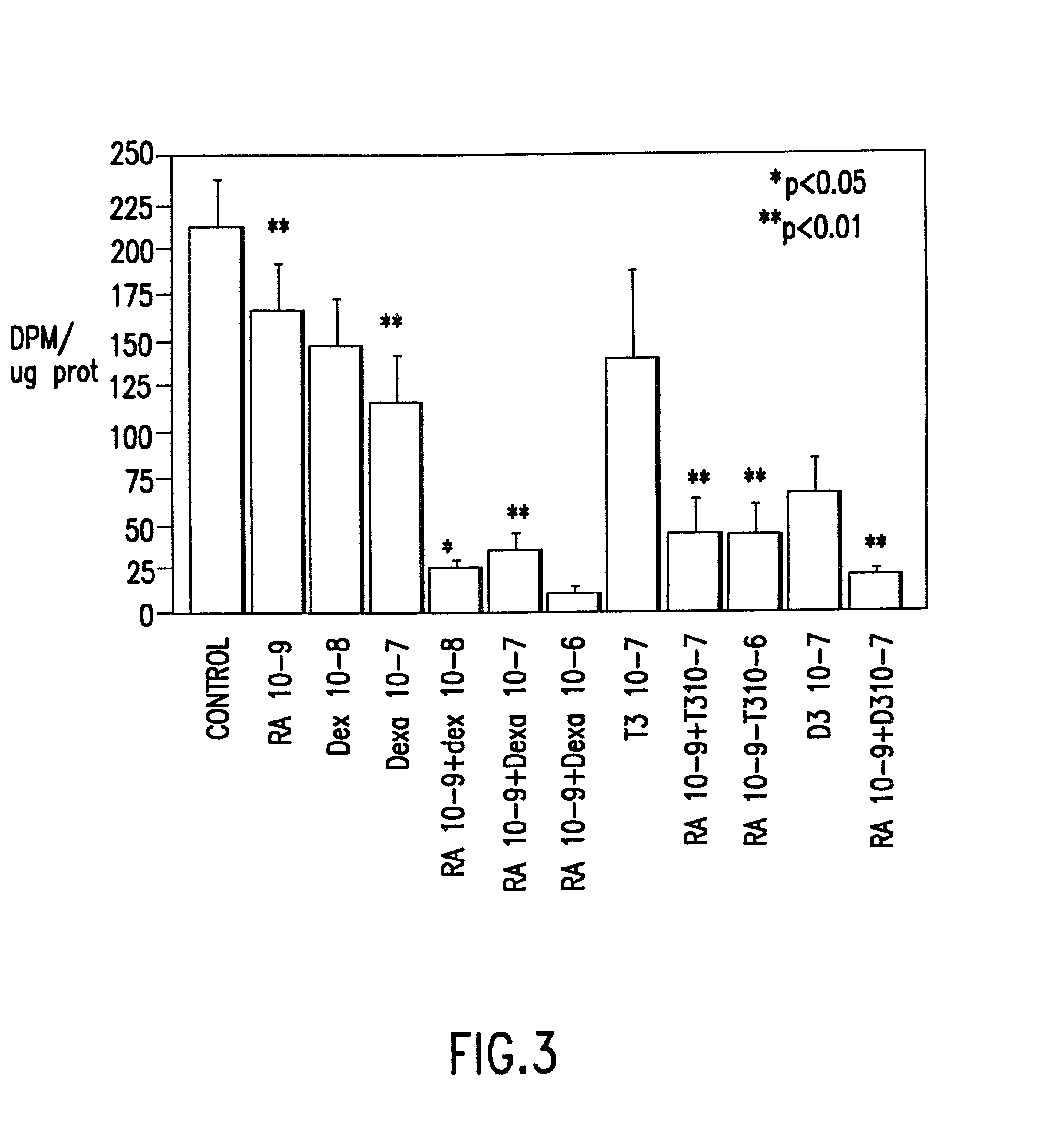Method of preventing proliferation of retinal pigment epithelium by retinoic acid receptor agonists
a technology of retinal pigment epithelium and retinoic acid, which is applied in the direction of drug compositions, biocide, heterocyclic compound active ingredients, etc., can solve the problems of a large number of failures, the most common cause of failures is pvr, and the development of cnv is not good candidates for laser therapy, so as to prevent the proliferation of retinal pigment epithelium and inhibit the ap1-dependent gene expression
- Summary
- Abstract
- Description
- Claims
- Application Information
AI Technical Summary
Benefits of technology
Problems solved by technology
Method used
Image
Examples
example 1
[0037] The transactivation properties of retinoids were determined by measuring their ability to induce transcription in the HeLa cells by transiently cotransfecting them with a receptor gene construct and a reporter gene. Since retinoid receptors are members of the steroid receptor family of nuclear receptors that are characterized by homologous functional domains, hybrid receptors were used that contain the amino terminus and DNA-binding domain of the estrogen receptor and the hormone-binding domain of the retinoid receptors, either RAR-.alpha., .beta., .gamma., or RXR-.alpha.. These ER / RAR receptors activate transcription by binding to promoter sequences recognized by the estrogen receptor (estrogen response element), but do so in response to a retinoid (D. Benbrook, et al., Nature, 333:669-672, 1988). Previous studies have shown that the activation characteristics of hybrid receptors are determined by their ligand binding domain. To determine activation of the hybrid constructs ...
example cell
[0094] Example cell calculation:
[0095] want 40,000 cells / well and 200 wells
[0096] have (X) cells / ml therefore, 40,000 cells / well.times.200 wells-total # ml cells
[0097] (X) cells / ml needed
[0098] Using a 200 ml filter unit receiver add total, #ml cells to medium and bring final volume to 200 ml. Mix well by pipetting.
[0099] 3. Add 1.0 ml of cells per well using a sterile 12.5 ml dropper. Shake plates back and forth (do not swirl). Incubate at 37.degree. C. in a humidified 5% CO.sub.2 environment overnight. Cells are about 40% confluent prior to transfection.
[0100] Transfection: DAY 2 PREPARATION DNA / LIPOFECTIN COMPLEX
[0101] 1. Using 50 ml polystyrene tubes prepare Lipofectin (LF) and DNA separately. Determine vol of LF and DNA needed for 2 .mu.g LF / well, 500 ng ERE-CAT DNA / well, 100 ng ER / RAR DNA per well. Determine total volume needed for experiment. (DNA concentration will vary between each plasmid prep). Separately dilute LF and DNA in Opti-Mem media (Gibco-BRL; Gaithersburg, Md.) ...
example
[0114] Example
1 Drug Dilution Vol add Final: 5 mM (initial) to well -log [conc.] 1 mM 10 5.0 316 .mu.M 10 5.5 100 .mu.M 10 6.0 31.6 .mu.M 10 6.5 10 .mu.M 10 7.0 3.16 .mu.M 10 7.5 1 .mu.M 10 8.0 316 nM 10 8.5 100 nM 10 9.0 31.6 nM 10 9.5 10 nM 10 10.0 3.16 nM 10 10.5 1.0 nM 10 11.0
[0115] Day 4 MIXED PHASE CAT ASSAY
[0116] 1. Wash cells in 12 mm wells once with 0.50 ml 1X PBS (no Ca / Mg).
[0117] 2. Using a 5 ml pipet add 100 .mu.l of a ice cold 1% Triton, 1 mM Tris-Cl pH7.8, 2 mM EDTA pH8, DNase I. Prepared as follows:
[0118] LYSIS BUFFER (hypotonic buffer)
[0119] 2.0 mg DNase I (Sigma, St. Louis, Mo.)
[0120] 4.925 ml water
[0121] 50.0 .mu.l 100% Triton X-100 (BMB)
[0122] 5.0 .mu.l 1M Tris-Cl pH 7.8
[0123] 20.0 .mu.l 0.5M EDTA pH 8
[0124] 5.0 ml
[0125] 3. Place on ice for 60 minutes. Agitate occasionally.
[0126] 4. Transfer 50 .mu.l of lysate from 3 wells at a time using titertrek multichannel pipet with tips attached to channels #1, #3, #6 to 96 U-bottom well (Costar, Cambridge, Mass.). Place (u...
PUM
| Property | Measurement | Unit |
|---|---|---|
| total volume | aaaaa | aaaaa |
| pH | aaaaa | aaaaa |
| pH | aaaaa | aaaaa |
Abstract
Description
Claims
Application Information
 Login to View More
Login to View More - R&D
- Intellectual Property
- Life Sciences
- Materials
- Tech Scout
- Unparalleled Data Quality
- Higher Quality Content
- 60% Fewer Hallucinations
Browse by: Latest US Patents, China's latest patents, Technical Efficacy Thesaurus, Application Domain, Technology Topic, Popular Technical Reports.
© 2025 PatSnap. All rights reserved.Legal|Privacy policy|Modern Slavery Act Transparency Statement|Sitemap|About US| Contact US: help@patsnap.com



